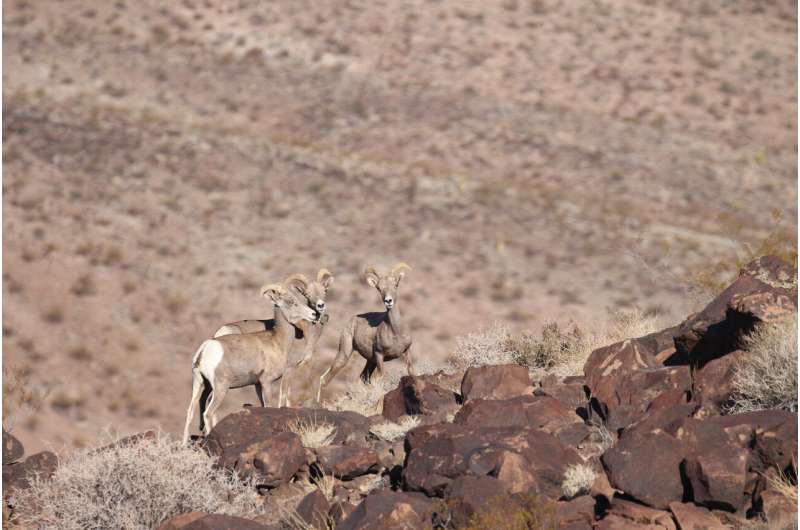This article has been reviewed according to Science X's editorial process and policies. Editors have highlighted the following attributes while ensuring the content's credibility:
fact-checked
trusted source
proofread
GPS tracking, simulations show optimal locations to help desert bighorn sheep cross freeways

Desert bighorn sheep whose Southern California range is bisected by freeways may one day benefit from Oregon State University modeling designed to show where the animals would be most apt to use overpasses to safely cross the interstates.
The research is important because it shows how GPS tracking data and computer simulations can be used to predict animal movements—information that's needed for the optimal siting of crucial but expensive habitat connectivity enhancement projects.
Findings of the study led by Christina Aiello, a research associate in the OSU College of Agricultural Sciences, were published in Landscape Ecology.
"Our work is already having an impact on conservation and land management decisions," Aiello said. "The study's findings are central to discussions among California officials about enhancing wildlife connectivity across barriers like interstate highways and a proposed Southern California to Las Vegas high-speed rail project. Government agencies and non-governmental organizations have voiced support for the construction of wildlife overcrossings at three key locations identified by our research."
A collaboration that also included Clinton Epps, a professor in the Oregon State College of Agricultural Sciences, and OSU graduate student Paige Prentice looked at GPS data from collared animals from nine populations of bighorn in the Mojave Desert.
The 20-million-acre desert includes Death Valley and Joshua Tree national parks and the Mojave National Preserve as well as Interstate 15 and I-40. The center divider of I-15 would hold the tracks of the proposed 200-mph train, which would be separated from auto traffic by a 6-foot concrete wall on either side of the rails.
Aiello, Epps and Prentice teamed up with scientists from the National Park Service to analyze bighorn movements as a series of step-by-step processes. That type of breakdown allowed the researchers to determine which landscape features the sheep prefer to travel through and which ones they would rather avoid.
"The computer models we used are known as step-selection functions because they determine what habitat bighorn select as they make steps from location to location," Aiello said. "There are no pre-freeway GPS data to show how bighorn used to travel, so we're using our models to simulate where bighorn would go if these freeway barriers were to suddenly disappear. Freeways continue to limit where bighorn can travel, even though they have been in place for decades."
The scientists ran simulations totaling 8,200 years in the lives of bighorn sheep—200 one-year periods apiece for 41 individuals, on landscapes with and without freeways. The results of the simulations sync up well with what genetics data and road kill numbers have suggested regarding movement corridors, the researchers say, and provide a more detailed look at how the sheep would benefit from a manmade-obstacle-free environment.
"Barrier removal increased accessible habitat for eight of the nine populations we looked at," Aiello said. "Our results can inform important ongoing land use and restoration questions such as, where should we build a wildlife crossing that bighorn sheep would benefit from and use most? And where should we not disturb land because it would interfere with movements that bighorn currently make to access habitat and interact with one other?"
That type of information, she added, is particularly important in desert habitats that continue to see large development proposals related to solar energy, transportation and urban expansion.
"There are limited resources in desert ecosystems that make movement and access to diverse habitats especially important to wildlife survival," Aiello said. "Our study provides a glimpse into how bighorn could use this landscape if they were free to move and choose the habitat they prefer—this helps us know how much the species might benefit if we improve movement across highways."
Neal Darby, Debra Hughson and Nathan Galloway of the National Park Service also took part in the research.
More information: Movement models and simulation reveal highway impacts and mitigation opportunities for a metapopulation-distributed species, Landscape Ecology (2023).
Provided by Oregon State University

















